By Clifford Woods Which Trees Can I Plant Near My Fish Pond? 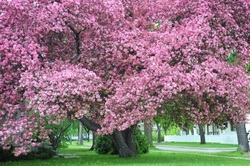 For pond keepers, it is essential to make sure that particular types of tree which are toxic are placed far from your fish pond. Most tree varieties lose their leaves, especially throughout the autumn season. You definitely do not want your pond fish to consume any of the toxic leaves that may fall into your pond; it could ruin their eating habits. On top of that, leaves are not nutritious for any fish.
Regardless of whether the leaves are dangerous or not, the elevated amounts of organic matter dropping into the fish pond is harmful as the leaves will at some point rot and sink to the bottom of the pond. Rotting plant life raises the amounts of carbon dioxide and ammonia in the water, which is extremely bad for the well-being of your fish.
A net spread over the pond is a practical option, yet it does take away from the overall physical appeal and experience of the fish pond. Nets may be necessary, or you could simply select tree species that do not shed a significant number of leaves.
There are some tree varieties that will surely supply a pleasant experience and shade for your goldfish, Koi and other aquatic life in your pond from a scorching summer day. The shade from the trees you choose will help to filter out ultraviolet rays, which subsequently assists in the management of algae. The cooler water allows oxygen to break down from the environment into the water considerably more effortlessly.When deciding upon trees to position around a fish pond, steer clear of the following: Additional types, while not particularly toxic, do possess huge root systems which will at some point hinder your pond liners are Sycamores and Willows. These are just two primarily examples of trees with large root systems that you should keep away from. Here also is a lists of a few trees appropriate for growing in gardens with fish ponds:
- Crab Apples are relatively tiny trees types which are a fantastic choice for gardening around a fish pond. The Japanese Crab Apple, as well as the fragrant Malus Pink Perfection are both excellent possibilities.
- The Swedish Silver Birch is fantastic if you are searching for mild foliage and a bark that progressively becomes white in color as time passes. For those who have an outside Pergola, positioned close to your fish pond and are seeking to add a few evergreen climbing plants next to it ensure that you stay away from deciduous plants like ivy. This particular plant type is among the most toxic of all climbers.
- A number of the ash tree types make the perfect option, since their root system is fairly compact and they tend not to cast an excessive amount of shade. The Mountain Ash tree has umbel-type blossoms in spring, accompanied by vibrant reddish berries in the autumn which are practically eclipsed by the spectacular red vegetation. The Japanese Mountain Ash yields sizeable orange berries.
Additional options are Mays or Hawthorns, especially if you require a tough and hardy plant. For those who desire an autumn look, a Crataegus prunifolia may be a good choice for you.
If you really have a desire for an evergreen deciduous climbing plant, then a Silver Queen is an excellent choice since it grows quickly and scarcely flowers; from time to time it does develop blossoms, however it is simple to prune them.
In case you already have an accumulation of decayed leaves in your pond, it is likely that algae are beginning to form if it hasn't already spread. An algaecide containing beneficial microorganisms is exactly what you need in order to obtain a thriving pond free of all bad bacteria.
 Author: Clifford Woods is the CEO of Effective Environmental Services and Organic Environmental Technology.
We brew Beneficial Microorganisms that eat toxins in the environment and offer Naturally Organic Solutions.
Which Freshwater Aquarium Plants Should I Use by Clifford Woods 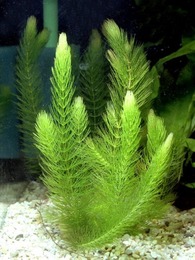 Vegetation in freshwater fish tanks makes it look fantastic and live, especially when properly lighted. They not only enhance the appearance of your aquarium, but also help with the all round natural stability of your tank's environment.
Much like plants above water, they help in the removing carbon dioxide and increase oxygen. Furthermore, they also assist in sustaining the chemical harmony of your tank's water by decreasing nitrate quantities.
Needless to say, proper care needs to be taken when adding any new component into a fish tank. With vegetation for freshwater fish tanks, exceptional care must be taken in the decision process to make sure that there are absolutely no unwanted effects to the fish, other plants, or the purification system due to their introduction.
To guarantee the best selection, get your plant life from a reliable supplier like a local fish shop; preferably one you know well. The plants should seem healthy at first glance. Any sort of wilting or abnormal browning may be indications of an incorrectly maintained plant or even a contaminated plant.
There are a few main types of plants that you can get for freshwater fish tanks. They are as follows:
Ferns and Mosses
Ferns and mosses can thrive with no need for a complicated root system. Therefore they are able to attach themselves to specific things like stones, decorations and practically any substrate present within your aquarium. These are non-blooming and supply great cover leaves for fish searching for a hiding place.
Stem Plants
Stem plants are a type of flowering plant; however they have a tendency to grow in a far more vertical manner than rosette plants which will be discussed below. These stem plants are ideal for setting up a forest-like background for your fish tank. It is advisable that you put them to the back of the aquarium, providing a beautiful background without hindering your view into the fish tank.
Rosette Plants
Rosette plants are thought to be great decorative plants. Varieties within this group will exhibit a fantastic array in colors. These will require special focus in the way they are attached into your substrate, as their root system is far more extensive than the roots of ferns. With this kind of plant life you should make sure you have a double layer of substrate in your tank.
A two inch base level needs to be applied specifically to deal with the nutritional requirements of this type of plant. Laterite is a red tropical soil and is extremely ideal for plants with extensive roots. Over the nutritional level of the substrate, a one inch covering on top of the substrate, of your preference, can be used.
Regardless of the variety of vegetation that you choose to put in your fish tank; you should supply sufficient illumination for their photosynthesis procedures to easily take place.
Furthermore, it is advisable to be on the lookout for algae breakouts as algae compete with your vegetation for nutrients. Be sure that you eliminate any algae development from the sides of the aquarium. If algae are located on the plants themselves, softly scrub the afflicted plants to get rid of the algae. A probiotic aquarium solution with beneficial microorganisms would be a good option for algae control and will not harm your plants.
Finally, if the plants are growing out of your aquarium, do prune them to keep them at a controllable and decent size. Plants for freshwater fish tanks do not need to be frustrating to deal with as quite a few beginner fish tank fans often consider them to be. With a little research and using the basic maintenance guideline as above, anyone can take pleasure in the visual elegance and environmental assistance which only live plant life can offer.
The Basics of Pond Care by Clifford Woods 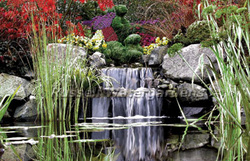 Proper pond care is comparatively straightforward on the condition that the pond is well-made in advance of putting fish into it as well as being properly maintained when in operation.
With both ponds and pools, you need to make sure that the proper water levels are taken care of, either by filling it in excess for the duration of hot weather seasons or depleting it in the course of rainier periods. This will prevent undue weathering of exposed areas of pond liner or erosion of banks if flooding occurs.
Splits in cement or holes in liners can often be fixed, however it is quite time intensive and certainly an issue worthy of avoidance. Appropriately blended cement should never fracture even during extreme climate changes. Most shredding in liners is a result of inappropriate selection of the proper fish pond liner in advance of installation, additional reasons are the feared visits from the otter, heron, raccoon, and other similar animals whose razor-sharp claws can effortlessly pierce weaker pond liners.
Fish Care
Assuming that your pond water is properly oxygenated and fish aren't over-fed, the fish should continue to be healthy. However, if you do observe fish behaving out of character or floating around too lethargically then in that case it is advisable to contact your local pond fish authorities. Protrusions or skin lesions are evident indications of stressed fish and really should be dealt with the instant it is observed.
Once again, a quick call to your own personal local fish pond treatment company to ask for a precise analysis and what therapy should be done is usually adequate to save your pond fish.
Seasonal Care
The later part of the fall and winter are generally not the ideal times of year to thoroughly clean your pond, as you will most likely disrupt all of the vegetation and fish attempting to adapt to the winter season. A few plants send down sprouts to the bottom level of the pond exactly where they sit until the weather conditions become a bit warmer.
The perfect time for an effective clean up is in early spring, following the last frosts, whenever pond life is back to being lively and the fish start to eat actively. Normally it is not recommended to completely drain and clean out ponds as this tends to get rid of the friendly microorganisms as well.
Improve Appearance and Protect Your Pond
To enhance the visual appeal of the pond as well as to protect against disease, get rid of any decaying plant life from the water and small vegetation following the initial couple of frosts at the beginning of fall, excessive floating vegetation that appears lifeless also needs to be taken out with a net or rake.
Fish during this period aren't going to be feeding and will essentially survive on their very own body fats for the rest of the winter season. Be sure you provide them with sufficient protection by means of ledges, rocks, or extremely deep water where they are able to hide securely.
Algae
Green unclean water is a frequent issue with more compact ponds. A small amount of algae exists in all water; having said that, in lengthier intervals of sunlight even an ideal equilibrium of fish and plants is just not sufficient for complete avoidance and the water can becomes a livid green color. In tiny still-water garden ponds this can be prevented with the setup of a purification unit such as UV sterilizers.
The UV light can eliminates algae cells, while the filtration system gets rid of its inactive organic matter well before it can lead to more complications. One particular method for eliminating algae would be to use an algaecide abundant with beneficial microorganisms.
A probiotics solution may be helpful in getting rid of algae completely as well as boost the overall health of the pond environment.

 Caring For Your Koi Pond During Spring
By Clifford Woods
Throughout the spring, your Koi fish pond will become more active. For most of their time during their deep winter sleep, the existing creatures in your pond are preparing to spring alive at the very first indications of the warm weather. This point is the most ideal time to care for your fish pond and preserve it well before your fish, vegetation, and other organisms in your pond return to life from their deep hibernation. Considerable changes will be taking place as the days and nights become warmer.
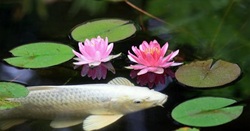 Simply keep track of temperatures and when it reaches about fifty degrees on average this will be about the most ideal time to take care of your Koi pond.
The upkeep necessary for your fish pond is dependent upon just what has occurred throughout the winter months. A harsh winter calls for even more modifications than normal. This is one of the reasons that it is a smart idea to start once caring for your pond as soon as you notice alterations in the climate. Always remember that servicing in the springtime must be carried out on an annual basis, regardless of how minor or severe the prior winter season has been.
Pay attention to the water quality of your Koi pond. You will observe that the pond's water is extremely clear when the conditions change from winter to spring. Do not let this clear appearance deceive you, because there are going to be variables which will result in serious complications once summer comes along if you do not solve these problems at the earliest opportunity.
 Throughout the autumn and winter months, leaves along with other plant substances could possibly have found its way into the fish pond. Despite the fact that the water appears clear, these components have inserted considerable amounts of nourishment in the water, which will lead to immediate algae development once the spring hits.
In addition, large quantities of natural materials in the pond will begin to go through decomposition, which will reduce the oxygen levels in the water. Now, because the water in your pond is extremely clear, this will be the ideal chance to clear all those undesirable debris and wastes.
You can accomplish this by:
- Employing a fine mesh net to scoop out most of those particles. At this point, the only real issue here is that many nets are only going to cause more debris in your pond as opposed to eliminating them from it.
- Once you have taken out those unnecessary particles and wastes, test out the quality of your water. The winter months would have caused changes in the pH quantities of the fish pond. At the start of the spring season, the pH volume of the water should be eight.
- Above all else, always remember to take care of and look after your fish. Take into account that spring is an extremely vulnerable time for your fish since they have not ingested any food for ages and they've been dwelling on a fairly low amount of energy. This could cause your fish to be far more susceptible to problems with harmful bacteria, viruses, fungi, and parasites. At this point in time, it is an excellent idea to take every one of the essential precautionary actions for your Koi and the overall health of the pond.
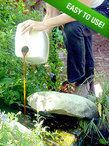 Manage your Koi pond with the addition of a probiotic algaecide solution filled with beneficial microorganisms which will substantially reduce those dangerous infestations and debris. As soon as the weather warms up, an additional amount of this kind of treatment solution will secure the well-being of your Koi as they rebuild their own defense systems.

All about Pond Magician and How to Use it Effectively
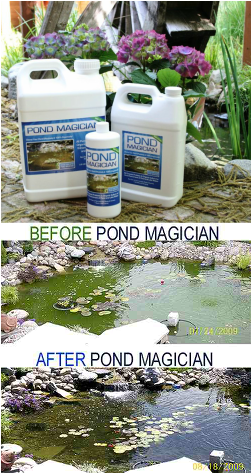 Pond Magician is made up of an incredible number of beneficial microorganisms that maneuver through your pond and consume the microbes and contaminants which make your pond unpleasant as well as foul-smelling.
Unlike similar pond cleaners which exclusively deal with natural materials, Pond Magician is made up of both aerobic and anaerobic beneficial microorganisms, therefore making it easily adaptable to a large selection of pond water situations.
What are Beneficial Microorganisms?
Beneficial microorganisms are composed of billions of friendly microorganisms. Generally, they simply eat up the algae and unwanted organisms. These microbes are advantageous to the water, plants, and fish life that thrive within your pond and they can be extremely eager for the impurities and organisms which make your pond unclean.
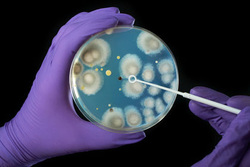 A few of the beneficial microorganisms can flourish even within environments where there is little if any breathable oxygen available. For this reason, beneficial microorganisms are quite effective regardless of the situation. Apart from being less expensive when compared with other deodorizing remedies, the application process is quite easy.
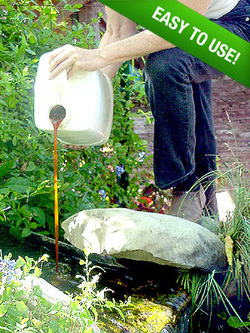 How to Use Pond Magician and Determine the Quantity Needed
Pond Magician is incredibly user-friendly. Simply pour it into your pond directly from the container. Put just a little at a handful of locations around the border of the pond or even dump it into the flow or waterfall for those who have one. The concept is to get the solution equally distributed within the pond.
You may also apply it on top of the pond's surface area with a backyard sprayer. This can help in the case that you have a large amount of surface algae.
Before you apply it, first you have to determine the amount of gallons in your pond by employing this basic formula:
- Multiply the average length in feet of the pond by the average width in feet.
- Then multiply that answer by the average depth in feet.
- Then multiply that answer by 7.48.
- This answer is the approximate number of gallons in your pond.
After that, making use of the guidelines below will determine the quantity of Pond Magician you will need for two applications.
- 0-1,000 Gallons = 1 Quart
- 1000-5000 Gallons = 1 Gallon
- 5,000 - 12,500 Gallons = 2.5 Gallons
- 12,500 Gallons or More = Please give us a call for precise instructions at (818) 897-4444
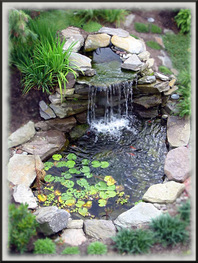 The Benefits of Pond Magician
As these beneficial microorganisms carry out their job, your pond will receive the subsequent advantages:
- The pond is going to have an extremely enjoyable, refreshing aroma.
- The pond water is going to be as healthy and crystal clear as water coming down a flowing mountain stream.
- The plants and fish will be extremely pleased and live longer.
Over dosage Precautions
Essentially, there is absolutely no chance of overdose due to the fact Pond Magician is made up of beneficial microorganisms. On the other hand, using more than needed will become significantly less cost-effective to the customer. In contrast to chemical products, where there exists a devastating consequence when overdosing occurs, organic bio-solutions only will stop functioning whenever there isn't enough excessive nourishment within the pond.
The main issue linked to overdosing beneficial microorganisms, besides cost, is the fact that when there is a great deal of natural and organic accumulation when you overdose, it is possible to induce an excessive amount of activity and need for oxygen. Basically, an over dosage of microorganisms would use up the oxygen in the water that sustains the fish. 
Algae: The Leading Cause of Fish Deaths in Ponds
by Clifford Woods 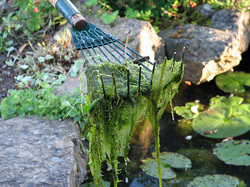
Fish pond algae are really a general name which represents all of the various types of algae, normally present in ponds. A few varieties of algae can actually be beneficial to the overall health of the pond while others types can be viewed as a real annoyance.
You will need to prevent as many algae blooms as you can in order to keep your fish and visual appealing pond vegetation alive. The most prevalent type is the floating green algae, like chlorella, euglena, and chlamydomonas varieties. They grow and reproduce quickly through cell division or spores.
Filamentous algae, also known as string algae, appear to be lengthy green noodles and have a hair-like visual aspect to them. The looks are a result of a combination of cells joined up end to end. Horse hair algae and blanket weed types like spirogyra, oedogonium, and cladophora are quite prevalent.
The Factors That Lead to Pond Algae Growth
The main three variables that enables pond algae to produce consists of: hot temperatures, vitamin abundant pond water, and crystal clear pond water that permits sunshine to pass through. A rise in temperatures speeds up both blanket weed and suspended green algae advancement.
How Various Algae Varieties Affect the Overall Health of the Fish Pond
Floating planktonic algae distribute at a speedy pace and can only be managed by ultraviolet illumination from a UV sterilizer. The UV spectrum splits the cell surfaces, resulting in the algae to collect together which in turn allows filters to easily remove the algae from the pond. An substantial amount of floating green algae can produce what is known as algae blooms. They could be devastating to pond fish as the blooms will at some point deprive the pond of oxygen thus killing off all underwater plants and fish life. 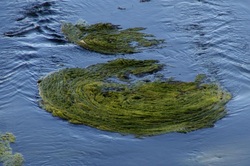 Why Too Much Algae is Harmful for Garden Ponds
Algae does not just make the pond seem unpleasant and overgrown, but in more severe situations, can actually cause the pond to smell foul. The rotting process of algae eats up oxygen from the pond water. This is especially harmful to the oxidizing bacteria and pond fish population, which both need oxygen to thrive.
Keep in mind that ammonia must be changed into nitrites by the oxidizing microorganisms. The oxidation procedure calls for vast volumes of oxygen to be able to take place. The rise in ammonia, which is additionally created by decaying algae matter, puts even more stress on the pond filtration system that houses the nitrifying microorganisms.
 How to Control Algae in Your Fish Pond
By far the most effective way of handling suspended planktonic algae is to make use of a UV clarifier or UV sterilizer. The ultraviolet spectrum eliminates the single-celled algae, resulting in it expiring and sticking to other deceased algal cells.
However, UV does not discriminate between good and bad microorganisms and will simply kill all of them. This is not really good for your fish. And not all algae are bad for a fish pond ; in fact, algae can be quite helpful to the pond because it supplies a way to obtain food for fish, presents shade from the sizzling sun, and offers as a shelter from king fishers, heron, along with various other birds.
Make an effort to cover a minimum of one third the surface area of the fish pond with plants, since they contend with algae cells for the accessible vitamins in the pond water.
Conduct regular cleaning by getting rid of string algae and blanket weed by using a garden rake.
It really is alright to have a bit of algae on pond surfaces, filtration systems, as well as other pond maintenance gear. The key is to keep it in check with a probiotics solution such as an organic algaecide created with beneficial microorganisms.
 Clifford Woods is the CEO of Effective Environmental Services
and Organic Environmental Technology.
We brew Beneficial Microorganisms that eat toxins and offer Naturally Organic Solutions.
Algae Management in Freshwater Aquariums
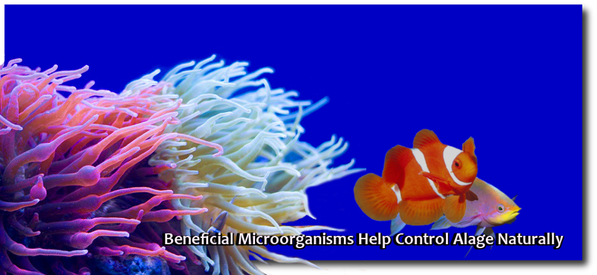 By Clifford WoodsAn aquarium tank can be quite the exceptional addition to a home or workplace. There isn't anything more relaxing than viewing fish swimming in harmony through the clear, dazzling tropical water. On the other hand, there is practically nothing more unpleasant than an aquarium tank abundant with algae.
Below are a handful of concerns and tips to assist with algae management.
Just about all fish displays contain algae. A small bit of it is not necessarily harmful, however if it isn't controlled algae can multiply quickly and take control of your freshwater tank which is extremely troublesome to clean, not to mention unhealthy for the fish.
Green algae are normal for most freshwater tank owners. The two main varieties, green dot and hair, can be time intensive in addition to difficult to eliminate from the aquarium.
These algae grow quickly in fish tanks that get an excess of sunshine. The darker types of algae, such as black brush, generally grow soon after the initial set-up of the tank.
The algae development in fish tanks that have already been set up for a longer period of time may be related to problems with the level of phosphate or nitrate in the water.
The growth of these algae may also linked to excessive amounts of light. In order to eliminate it from the fish tank, in most cases you have to clean the entire tank extensively, decrease light exposure, and also make certain that the water condition is at a suitable temperature.
Blue-green algae and red brush are two additional varieties of algae that may develop in a fish tank. The red brush variety generally has a tendency to form in fish tanks having higher pH levels. Blue-green algae are a slimier type which can be dangerous to both vegetation and fish in the tank.
One of the better processes to inhibit the development of numerous algae would be to manage lighting. For algae management, never place fish tanks close to windows and be sure to reduce the lighting to eight hours on a daily basis. Employing a lighting timer is a fantastic way to supply your fish tank with suitable quantities of light.
Much like your fish, algae have to consume to live. Algae develop best through taking in phosphorus, potassium, and nitrogen. You have the capability to significantly enhance algae management in freshwater fish tanks by making certain that your tank is not overwhelmed by fish waste products, excessive food, or rotting vegetation. Additionally, perform water adjustments regularly and use a properly measured filtration system.
Incorporating algae consuming agents to your aquarium would be a good option. Snails and algae-eating species of fish are able to assist in the management of algae within the tank.
You should be aware that snails can populate remarkably quickly, however with proper control including a snail and an algae-consuming species to a fish tank could very well be an excellent idea. Take note that when all of the algae are consumed, you are going to have to feed these fish with store-bought food.
It is not unusual for algae to start to re-populate within a clean fish tank during a time span of just three weeks. For regular algae regulation, be mindful with regards to overfeeding your fish, promptly remove any dead fish from the tank, be aware of the amount of light that the aquarium receives, and also use some type of filtering method.
Additionally, remove any obvious algae with a scrubber designed for this sort of cleanup. A really simple way to eradicate algae from a freshwater fish tank would be to apply a probiotic algaecide.This type of solution is perfectly safe for your fish and actually benefits the water in numerous ways due to the beneficial microorganisms contained with the product.

5 Key Factors of Green Pond Water
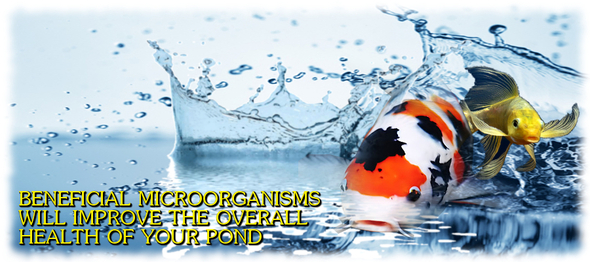 By Clifford Woods
Algae overgrowth can have disastrous consequences on the well-being of our ponds. Below are five factors that contribute the algae development and how it can be stopped.
#1: Excessive Fish
If this sounds like your situation, then immediately limit the volume of fish or add to the size of your organic filtration system. Keep in mind that fish grow in size and in quantity, therefore the scale your organic purification system which you believed might be the right size in the beginning, may not be the proper size for your pond now.
#2: Seasonal Changes
It is the start of the springtime or the later part of the fall when the pond encounters its largest change in the temperature of the water and biological bacteria development. If this is the situation, try to be calm and give your pond a few additional weeks.
Every single pond takes around four to six weeks in the beginning of the season to discover its new environmental equilibrium. When this occurs, the pond water will likely be green in appearance. In fact, you can count on it. At any time you increase the water level of your pond during the year, your pond is likely to turn green as well.
Simply add the most appropriate beneficial microorganism’s solution to provide your pond with good aeration and stay patient. Bear in mind, it will require several weeks, not just a couple of days. Never persistently drain and refill your pond because you will be consistently altering its ecological stability that it's striving to achieve – so give it a hand, be patient.
#3: Accumulation of Organic Matter
For those ponds that have more organic substances, like dead leaves, fish wastes, muck, sludge, and so forth, in them than the amount of beneficial microorganisms in your filtration system where beneficial microorganisms reside and flourish, you may either have to add to the size of your organic filter or increase the total quantity of beneficial microorganisms in your pond.
You can do this by one of two ways; basically increase the size of your filter of add more beneficial microorganism to your pond. You need to be incorporating beneficial microorganisms on a regular basis into your pond in any case.
#4: Too Much Water
Remain calm with your pond as it sets up its new environmental equilibrium. This often completes in about four to six weeks following the previous time you have added extra water. Whenever you add more water, you cause a difference in the pond which causes new algae to prosper and green water to occur. Simply have patience and increase the amount of beneficial microorganisms you add to your pond.
#5: Other Factors That Could Be Causing Algae and Killing the Beneficial Microorganisms in Your Pond
If you are introducing fresh water into your pond on a regular basis; quit doing so now. Allow the pond to find its new environmental stability. In the case that you are including beneficial microorganisms to it, but not disabling your UV clarifier or UV sterilizer, then make sure to turn it off no less than three to four days just prior to when you added the bacteria to ensure that the microorganisms have had an opportunity to attach themselves to the surface area within your pond or organic filter.
A few chemical compounds put into the pond can also be the reason for precisely what is wiping out your beneficial microorganisms. If that's the case, invest in an organic algaecide that contains beneficial microorganisms. You'll be killing two birds with one stone with such a solution as you will be eliminating algae as well as replenishing your pond with bacteria that will improve the pond's overall health.

How Does Phosphate Get Into A Pond
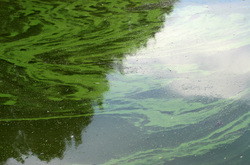 By Clifford Woods Ponds under attack from green water, poor coral growth, algae and cyanobacteria and are the things that are responsible for your dying fish. These are factors that generally leave aquarists frustrated, and most of them, are brought about by the presence of phosphate in water.What Are Phosphates?Phosphates are naturally occurring compounds, which commonly form in water bodies. This is largely due to a number of sources, the major one being water sources. Soil and salt mixes that are swept into the water as a result of rain or wind are a major responsible for phosphate infestation in ponds and these are usually harder to control than aquarium water. It’s important to note that phosphates are the active ingredients in fertilizers. That being said, salt mixes that could be found in rocks surrounding the pond may be the reason why your water is choking.How Can You Identify High Phosphate Levels?Identifying the signs of high phosphate levels can be obvious (if you know what to look for), or they might be a bit more subtle and hard to recognize but here a re a few:- The water color
- Predominant presence of nuisance algae
- Poor coral growth
Your water could indicate the presence of phosphates and if your pond is pea green, you need to think about phosphate testing. Nuisance algae predominance is also a good sign that your water is thriving with phosphates, since like already mentioned; it is the active ingredient in fertilizers and therefore, encourages growth of plants. And Algae of course is a plant.Types of algae to look out for are black hair algae and slime algae as well. You can also identify signs of poor marine, such as unhealthy corals and poor survival rates of invertebrates, such as shrimp and snails. There is several phosphate testing kits you can use to identify phosphate presence in your water.How to Remove PhosphateEliminating phosphates can be quite tricky and before you can conduct any elimination process, you need to first identify the cause. If you throw frozen foods into your ponds, this may the reason why there are high levels of the compound. You may want to consider rinsing foods before feeding your fish or simply avoiding frozen foods. The water that frozen foods are frozen in sometimes has high phosphate concentrations. Are there golf courses, farms or even fertilized gardens and lawns around your pond? If yes, run offs from the rain are washing these phosphates into your pond. Once you’ve identified (and hopefully eliminated) where the phosphate is coming from, you can start getting rid of what you already have. Water changes with phosphate-free water can help cut down on your levels but can take time before you see a noticeable difference. In saltwater aquariums, protein skimmers can help remove wastes and decrease the phosphate levels, and refugiums can be used in freshwater and saltwater tanks. There are various products in the market that can help you get rid of phosphates. These mediums act to absorb the compound or trap it for removal. When a phosphate remover is applied into the water, it basically traps the phosphates and immobilizes them, making them insoluble nutrients. Phosphates in ponds are harder to eliminate, since you cannot control what products people use in their lawns and farms. That said, you can control the levels by always ensuring that your pond is clean and using a phosphate remover often. With persistent testing and removal, your pond can have a good water quality for your fish and other marine species to thrive better.
Clifford Woods is the CEO of Effective Environmental Services and Organic Environmental Technology.
Find out more about pond care at http://www.effens.com
We brew Beneficial Microorganisms that eat toxins in the environment and offer Environmentally Friendly products.
What is Phosphate?
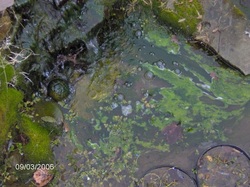 By Clifford Woods
Phosphates, which contain phosphorus, are essential nutrients that contribute to the growth and metabolic reactions of all animals and plants. The quantity of phosphorus can either increase or limit growth. Since it is essential to the growth of plants and animals, an imbalance in the amount of the natural growth of phosphorus can produce harmful changes to the environment. This is when it becomes a job for a phosphate remover to handle.
Contributing Factors In Phosphates Overgrowth
The internal contributor in the growth of the presence of phosphates in your fish pond is from the mineralization of dead matter, such as plants, uneaten food, feces, fish slime, bacteria, etc. The rotting food particles or dead plant materials settle either within the filter or on the substrate. Vacuuming the gravel or rinsing filter materials every time you change the water in your pond or tank will substantially decrease the potential accumulation of phosphate deposits. The probable external sources, on the other hand, are additives such as frozen fish food, carbon or pH stabilizers.
Effects Of Phosphates In Fish Ponds
For people who raise fish on ponds, the elevated presence of phosphates means algae invasion and that is a big threat to the lives of your fish. Using a phosphate remover is ideal in this kind of pond situation. Partially, changing the water in your fish pond more frequently can also help. Once the growth of water weeds and algae in your pond becomes uncontrollable, they will dominate the use of oxygen until the water in your pond will not be able to support the life of your fish any more, leaving them to die. So, use phosphate removers as soon as the presence of phosphorus becomes threatening.
Addressing The Issue With Phosphate Removers
The ideal amount of the presence of phosphates in your fish pond should be below 0.005 ppm. A phosphate remover will control the level of phosphates in your pond by reducing the amount of algae that grows in it.
When phosphate removers are applied into the water, it basically traps the phosphates and immobilizes them, making them insoluble nutrients. Phosphates in ponds are harder to eliminate, since you cannot control what products people use in their lawns and farms.
That said, you can control the levels by always ensuring that your pond is clean and using a phosphate remover often. With persistent testing and removal, your pond can have a good water quality for your fish and other marine species to thrive better.
For salt-water aquariums, it will maximize the coral growth in it. When buying them, make sure that you thoroughly check the brand specifications. Most often, it comes as phosphate mesh media bags or reactors.
Those that come in reactors need to be installed, while those that come in mesh media bags are packed with phosphate removal media and employed inside the sump or canister filter.
If you want to be rid of a persistent phosphate problem, be vigilant in eliminating the causes of its overgrowth in the first place instead of always relying on a phosphate remover to do the job for you.- Avoid over-feeding your fish to reduce or eliminate the presence of uneaten foods. Choose a brand of fish food with the lowest levels of phosphates.
- Perform tank maintenance regularly by vacuuming the bottom of your ponds or tanks to remove plant decay, fish waste, and uneaten food.
- A filter’s job is to skim all dirt, so make sure you always remember to clean it, too.
Keep all these important maintenance steps in mind for your fish to have smooth-sailing lives.
Clifford Woods is the CEO of Effective Environmental Services and Organic Environmental Technology. See more info here: http://www.effens.com
We brew Beneficial Microorganisms that eat toxins in the environment and offer Environmentally Friendly products.
|


























 RSS Feed
RSS Feed